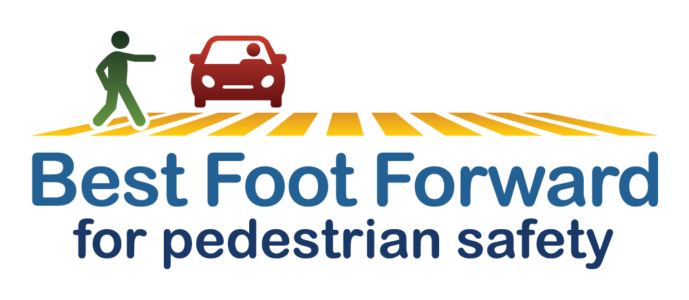Hosted by Bike/Walk Central Florida, the Best Foot Forward (BFF) Summit of 2024 continued its…

RRFBs drive change on Central Florida roads
Imagine you live at the Lancaster Villas Apartments at Lancaster Road and Voltaire Drive. You want to go to the grocery store, or a restaurant or church. The good news: all those things are right across the street. The bad news: that street is five lanes wide and cars often fly down it going much faster than the 45 mph speed limit.
Then one day, you go out to cross the street and notice a big change—Orange County crews have installed a new sign with strobe lights on it. If you want to cross the street, now you push a button, the strobe lights start flashing, and the drivers stop to give you time to walk across Lancaster using the crosswalk.
Rectangular Rapid-Flashing Beacons, or RRFBs, can make a huge difference when it comes to crosswalk safety. They are often installed when a crosswalk is in between two intersections. It’s called a mid-block crossing.
It’s not a shock that the addition of flashing lights at a mid-block crosswalk would have an impact on whether or not drivers stop. The kicker is how much of an impact they have – 47% fewer pedestrian crashes, according to the Federal Highway Administration.
The goal of the Best Foot Forward program is to get more drivers to yield for pedestrians in crosswalks, thereby reducing driver-versus-pedestrian crashes. BFF uses the Triple E approach to changing driver behavior: Education, Enforcement and Engineering.
RRFBs are a great example of how engineering changes at a crosswalk encourage more drivers to stop for pedestrians using that crosswalk—thus making the street safer for everyone. Unfortunately, these life-saving devices come with a hefty price tag – just one RRFB costs an average of $22,250. Often utilities workers need to relocate lines and pipes. The good news is that they are proving their worth.
Best Foot Forward has worked with planners and engineers in both Orange and Osceola counties to monitor crosswalks before and after RRFBs were installed. We’ve seen firsthand how these countermeasures get drivers’ attention and get them to stop.
Take that crosswalk at Lancaster Road and Voltaire Drive. Before the RRFB was installed, BFF tracked just 25% of drivers stopping for people trying to cross the street in the crosswalk. After the RRFB, that number jumped to 85% in just one month.
When BFF first started monitoring the crosswalk at Landstar Blvd and Misley Drive, only 7% of drivers were yielding for people walking – that’s roughly 7 out of 100. In 2017, after an RRFB was installed here, that number jumped to 61% (and now, it hovers around 65%).
Shift gears down to Osceola and you’ll see similar results. In 2018, an average of 29% of drivers yielded to people crossing at W. Donegan Avenue and Coral Avenue. After an RRFB was installed in March 2019, that number increased to 78%.
With results like these, it’s hard to argue the effectiveness of these crosswalk additions – the data speaks for itself, and we’re looking forward to seeing yield rates increase at other locations. The cities and counties already have plans to add additional RRFBs throughout Central Florida this year, including at the following BFF-monitored crosswalks:
- City of Orlando: Lake Baldwin Lane & Cady Way Trail in late 2019
- Orange County: Rio Grande Avenue & 40th Street in late 2019
- Osceola County: Old Dixie Highway & Sawdust Trail in June 2019




This Post Has 0 Comments